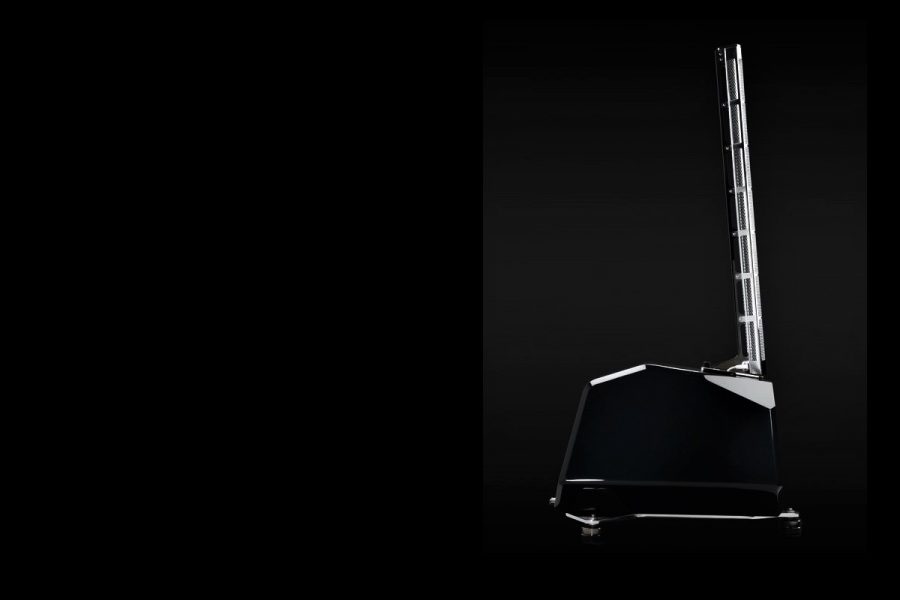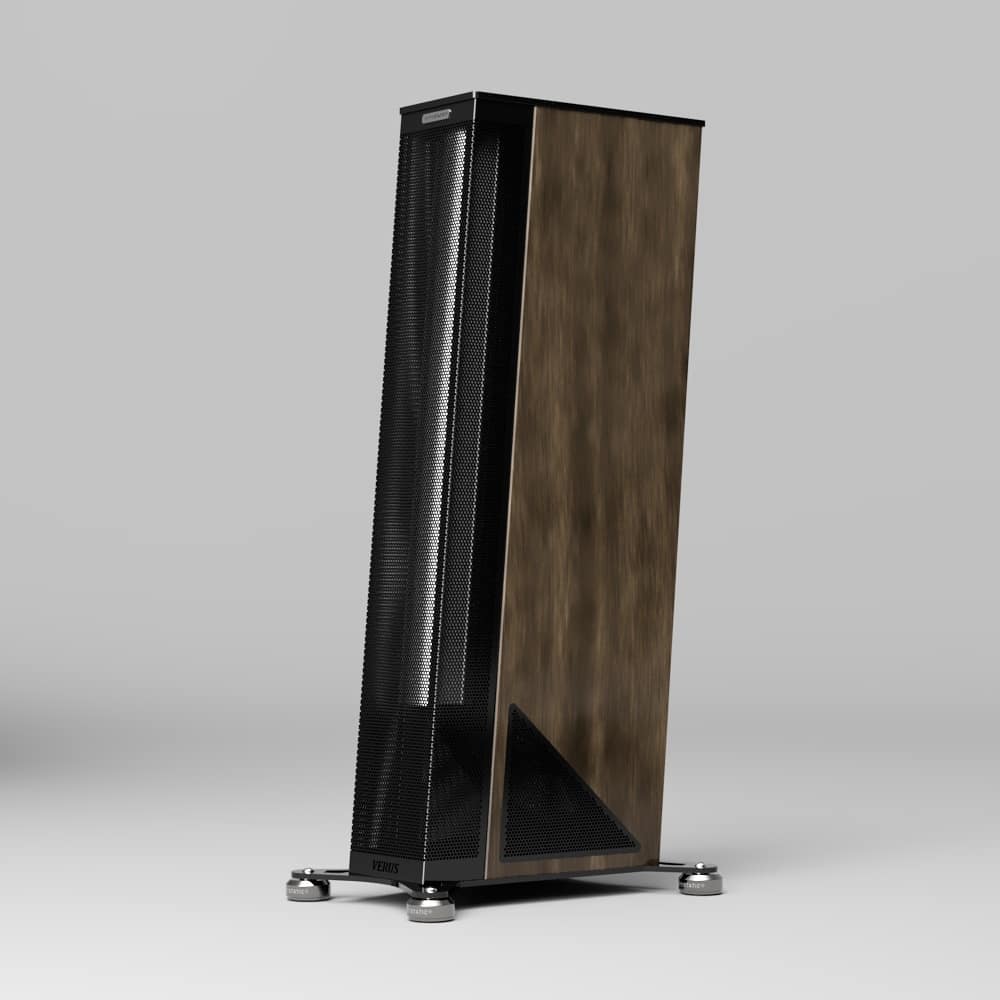Motto: Beauty from a technical project and a startling resolution of the soundstage.
While wandering the hallways of the Helsinki HiFi Expo last November I walked into a pair of delicately designed shining loudspeakers that immediately stole my attention although I didn’t, first off, know what to think about them. In that surrounding, the contrast was obvious. HiFi Shows are generally speaking a play ground for massive loudspeakers, and outright masculinity, and that was true of the Helsinki fair too albeit to a lesser extent perhaps. Compared to giants of the neighboring rooms this speaker looked as if made of bird’s bones.
The speaker is Absolute Dimension’s first creation, the 2-way Hypostatic Indigenum, and naturally the rather unusual looks titillated my intellect so much that I decided to find out more about this unorthodox sound transducer.
Absolute Dimension is a small company located in a small country town (Ikaalinen) in the central part of Finland surrounded by lakes and cornfields. The town is famous for its 1884 founded Spa nowadays far from its peak times.
Anyway, I decided to pay a visit to the Absolute Dimension’s main office and listening room hoping to be able to audition the speakers in peace and quiet (peaceful and quiet it really was) and maybe pose some questions directly to the speaker’s father and designer Jari Ollonberg.
”As long as I remember I’ve been interested in sound systems, especially loudspeakers, and built some DIY ones, and studied the issue of speaker building by reading books and magazines focusing on loudspeaker technology and design. Ten years ago or so I saw an article dealing with the problem associated with magnetostatic planar speakers, namely their being too directive at frequecies where the wavelength is shorter than the width of the diaphragm. An idea immediately leaped to my mind: Could the diaphragm be made curved so as to avoid the problem? As the subject matter continued to bother me it was only natural that the next step was trying to solve the problem by building a prototype. So I did and here we are.”
Right, so the impetus for designing the speaker came as much from solving a purely technical problem as from the anticipation of developing a great sounding loudspeaker. So what happened next?
”When I first heard the sound of the prototype, I soon realized why the hobbyists so enthused about the magnetostatic concept. Even at this preliminary stage the sound was extremely precise and natural, really great! It felt I might have invented something new. To the best of my knowledge there was no similar loudspeaker around on the market. So how could I have stopped developing the concept further? Solving the problems related to manufacturing the curved diaphragm for the HF driver, finding the right materials, etc. took endless number of hours and several proto versions over the following ten years.”
Finally in 2018 Jari Ollonberg was confident enough to start as an entrepreneur and so the company called Absolute Dimension was set up. The first model to come out from the production line was Hypostatic Indigenum, and naturally it sports the company’s unique CMD driver. Hypostatic refers to the Series, Indigenum being the model name.
Hypostatic? What sort of name is that?
”I heard the word ”hypostasis” on a radio program. For some reason I got good vibs about it, so much so that I ended up looking it up from Wikipedia. The word turned out to have several meanings but in philosophy it was reserved for the ”underlying substance and the fundamental reality that supports all else.” That sort of idea went well with the idea I had about the sound of the speaker: the ”real” being exactly what the recording is fundamentally made to contain, the basic material, nothing added. And of course, the static annex has an obvious link to the magnetostatic. The model name Indigenum refers to ”original” and that in my head illustrates the speaker’s ability to reproduce the sound in its original form. Or at least that’s the aim.”
And the design? Where does that come from? Is this again one of those ”form follows the function” realizations?
”Design is often a result of a series of random factors, a process that is hard to foresee. At first I designed a test cabinet, the bass part made of thick plywood, along the lines familiar from the Martin Logan Ethos for example. In the next phase I then had some really fancy and wild ideas for the woofer cab. Reflecting the design is of course reflecting about the materials, and when I discussed the issue with a friend, he drew my attention to a brand new material, stone-composite, that enables making use of unusual shapes. Since I already had fallen in love with angled forms, I decided to give a try to this new material, and the degrees of freedom it brought along, in designing the woofer cab. That was also how I got rid of the extra volume and extra size of the bass enclosure of my first prototypes. The box partly spreading behind the pillar the structure was a way too massive!
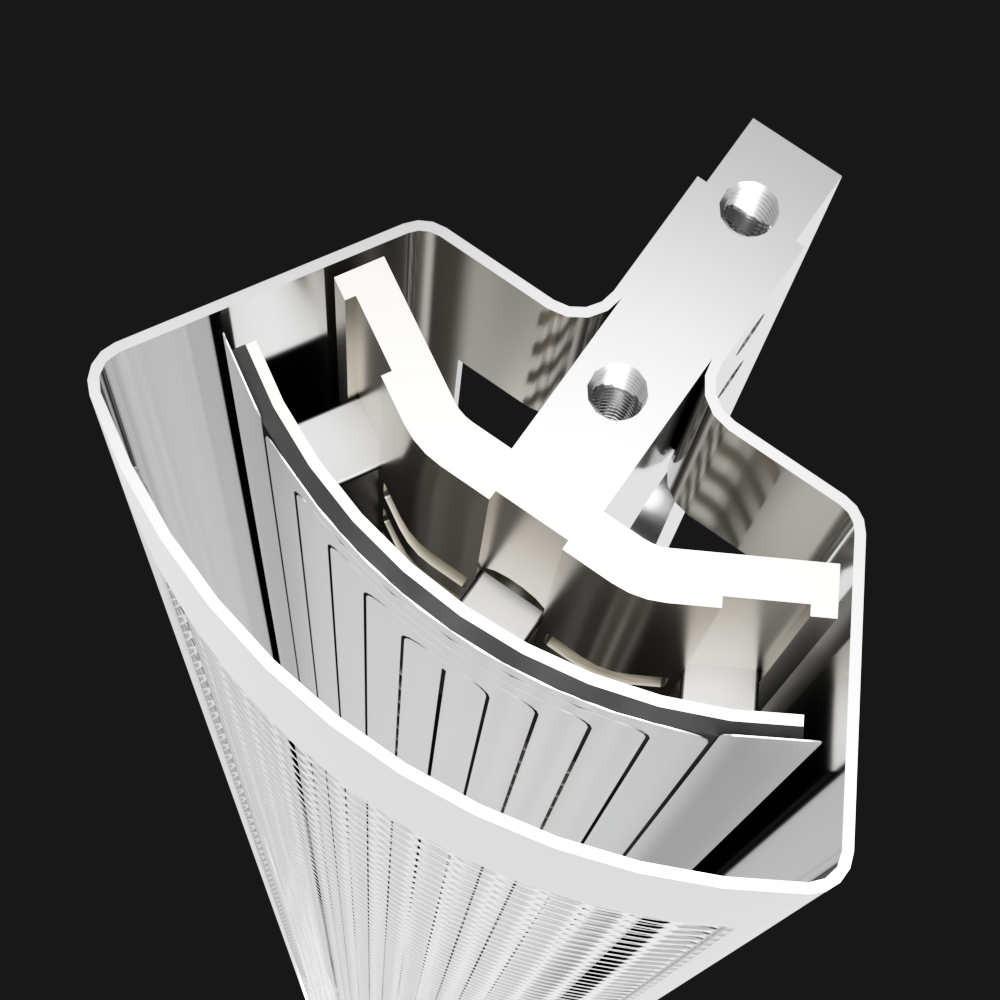
Well, here’s a stupid question that springs purely from the outlooks of the Indigenium: how does a speaker as beautiful and slender as the Indigenum, with the structure it has, is capable of reproducing heavy music ranging, say, from the sound of a massive symphony orchestra to heavy progressive rock? In other words, would the aesthetic demands of ‘heavy music’ require a less pretty loudspeaker?
“I’m inclined to think that if the sound track, in terms of mixing and mastering, is executed decently and correctly, any music goes for my loudspeaker. Over the period when I was testing my speaker with music I of course was listening to a variety of different program material. It was there that I found that for instance among metal music there are some really quality albums as there are many really bad ones, which I could hardly listen at all. My theory stipulates that the cause for this this state of affairs lies in the studio staff, and their use of lousy loudspeakers for mastering purposes. If the person who does the mastering simply does not hear, say, the presence of distortion in the sound, how can he cut it off from the recording? And he doesn’t because his speakers simply do not reveal or make the distortion audible. And then, when such a recording is listened through the speakers at home, preferably with ones that sport a light film diaphragm, and that are discriminating and able to follow the signal accurately, the sound is bound to be unwanted. Of course, bad mastering is not unique to metal music, but metal music typically makes use of massively distorted guitar sections.”
Technically, how hard it was to make the two sound sources, the narrow static HF pillar and the woofer block perform seamlessly in an acoustically integrated manner? After all, they are different with respect to sensitivity, directivity etc.
”This is a matter that speaker designers often wonder. Very often the observance of some theory, or general beliefs, rules out many intriguing solutions already in the developing phase. Take the passive radiator, for instance. The size of the passive element I chose has bothered some people because they’ve taken as the truth that the size of the passive element should be about twice the main woofer. But as far as I’m concerned there’s no final strict evidence for that “recommendation”. To me the question is only about the sufficiency of the displacement at the very low frequencies and at a really high volume. If the displacement of the passive woofer is occasionally used out, it only limits the dynamics, but by then we’d probably be deaf anyway because the sound pressure had to be far beyond the normal level. That is, in practice my passive radiator works really well, although in theory some problem may exist. Note that prior to ending up using the monopole with a passive radiator, I experimented with a ported design, cardioid and dipole woofer cabs.
Personally I stress the role of the on-axis response in my designs. When the response is fine, measured from the listening distance for + -20 degrees, almost everything else falls into place, and I wouldn’t be too worried about the smoothness or uniformity of the power response either because every speaker, regardless of its operating principle, has to be placed in a space either by listening and/or measuring and carrying out some measurements in order to acoustically treat the room. If a speaker is designed and offered as a universal solution for every possible room, then certain potentially beneficial solutions are precluded. I’m sure other designers would probably answer the question more in theoretical terms, but to me questions like this are practical in nature rather than anything else. If something works in practice, then it works, despite the theory.”
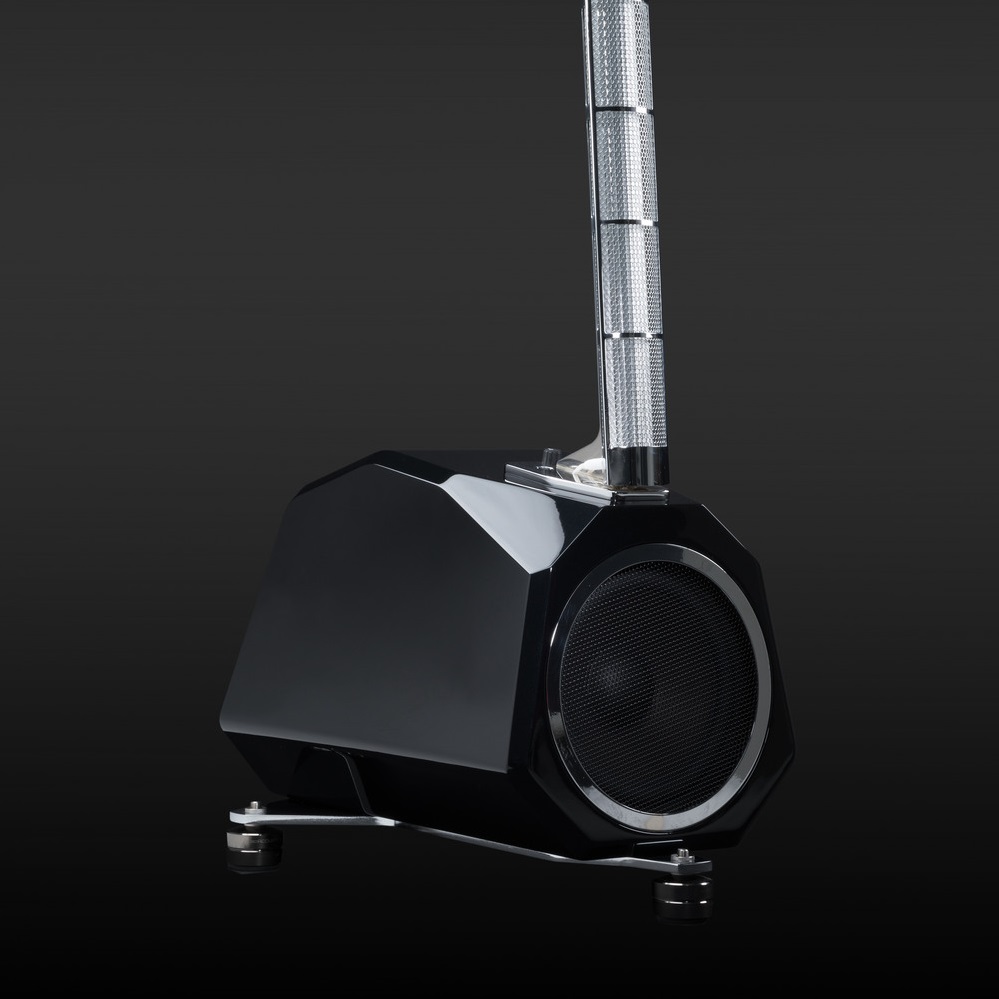
Some tentative reflections about the sound
Let me remind you: the purpose of my trip wasn’t to pen down a review of the Hypostatic Indigenum loudspeaker, so this ain’t a review. I did stuff my standard bunch of selected CDs in my haversack, the ones I use for critical listening but putting together a full review would have necessitated many other preconditions, and that wasn’t possible nor expected in this case. But I did briefly listen to the Indigenums, or rather music through them, trying to make explicit to myself what the speaker’s characteristic sound would be like.
Not unexpectedly, the sound was, not necessarily particularly huge but enormously airy and non-boxy, ie. not at all speaker-like, or at any case, not conventional speaker-like. Some people like the sound of box speakers probably because of the sound’s sheer physicality, concreteness, but the Indigenums make the identification impossible: there’s no way of pointing the sound source with the finger.
There are at least two ways in which the sound can be non-boxy. The one is how eg. the Gradient Revolutions do it, ie. by cancelling (cardioid) almost all backward radiation from their upper part (above 200Hz) and leaving the sound hover in the middle of the speaker cabs, clearly and even hilariously unconnected to the speaker cabs. The Indigenums, however, being dipoles do not prevent the rear radiation, quite the opposite, and therefore the sound is everywhere rather than somewhere including behind and around the pillars but never quite appearing to come from the pillar itself. The airiness and unconnectedness of the sound of the Indigenums is more akin to the sound of electrostatics, and perhaps even exceeding their performance in this regard, but of the different quality. The sound’s airiness is also different from the intangibility of the omnis, or from the indeterminacy of the bi-polars. This is certainly one of the great and unique features of this speaker.
The sound is not just airy but the speaker also accurately pinpoints the location of the sound sources in the horizontal plane (the position on the stage). As far as HiFi is concerned such pinpointing is mostly considered a virtue but there are people out there who don’t fancy such precise horizontal segregation, well, precisely because it appears so HiFi, ie. slightly artificial. In a live music event the sound is approaching the audience as a monophonic wave from the whole width of the stage, rather than horizontally cut in slices. On the other hand, much depends on the recording at hand, and how the soundstage is mixed and panned. The Indigenums reveal these differences, sometimes even mercilessly. With one sample they centered and nailed the sound right in the middle of the speakers so tightly that I had to go and check that the recording was indeed stereo and not mono! The Indigenums must be one of the most capable loudspeaker on the market in this regard.
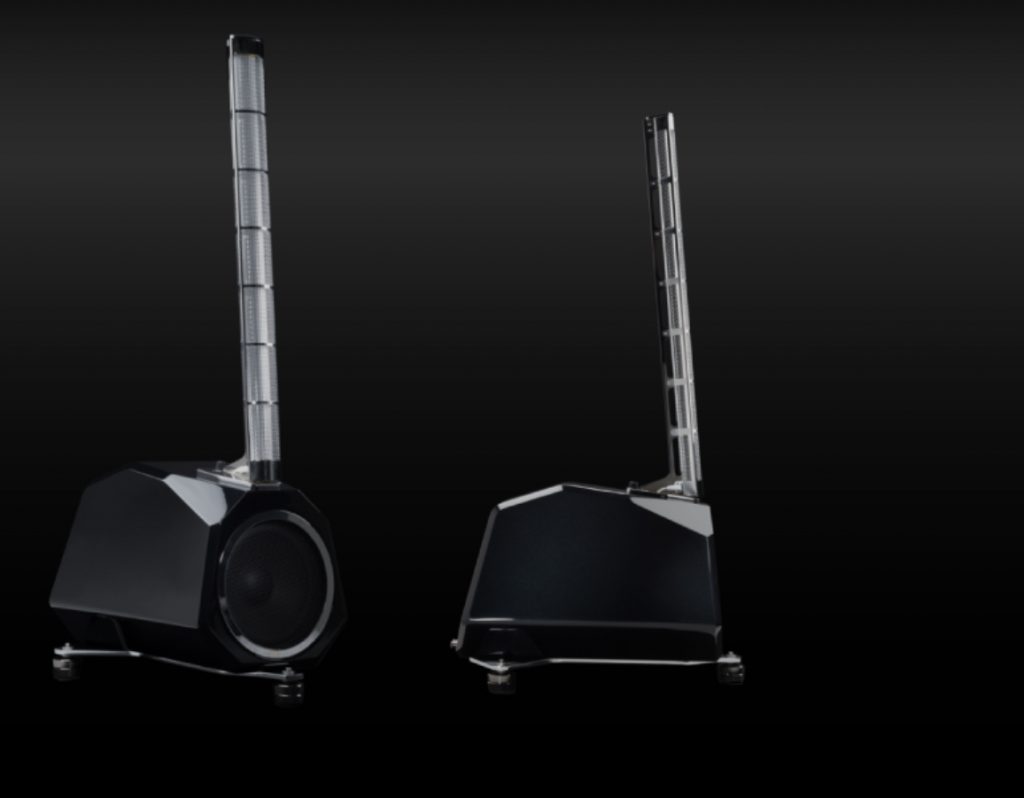
Despite sounding airy and dematerialized the main focus of the sound remained sufficiently at the line between the speakers and, which is important, didn’t withdraw too far back, as might be the case wit this type of speaker, leaving enough presence eg. for well recorded orchestral music. Keeping the balance in this regard is crucial for the wholesomeness of any speaker sound, and the Indigenums passed the test.
Another obvious feature of the Indigenums is their resolution. Jari Ollonberg pointed to me a track from the Eva Cassidy’s album where one instrument picks up a resonance from another one, and the move is clearly audible with the Indigenums but not necessarily with all other type of loudspeakers. Naturally, I couldn’t make a valid comparison but somehow it felt only obvious that the speaker enables hearing certain details better than on average, perhaps thanks to the CMD driver, lack of cabinet resonances and the like.
The spatial performance and the resolution being of a high level, excellent even, what about the rest? The bass for example? Here things are getting relative. On one hand it’s evident that the Indigenum’s two 11 inchers (the other passive) in a monopole configuration can provide substantial bass for the good of most music that reasonably requires it, from basso continuo of the Baroque orchestra to tapping the low strings of the electric bass guitar in fusion jazz. On the other hand, people who reasonably or unreasonably, are hunting the the lowest imaginary notes might consider the bass reaching just the halfway point. To be honestly 20 to 20k full-range loudspeaker is not among the priorities of the Indigenum, and if I’m asked, the manufacturer’s order of preference is well argued.
The crossover frequency for the HF static driver is 500Hz instead of, say, 200Hz meaning that the 11 inch woofer is now asked to cover almost the four lowest octaves before handing over the responsibility to the pillar. That is, it is the woofer that is asked to reproduce the lower midrange, tonally so important for the vocal music for instance. I didn’t perceive inconsistency in this respect but I noticed some anomalies in the vocal range higher up. They may have been caused by reflections from the listening space, and as such not real at all, or I was just listening to some defects of the recording that I was not aware earlier on. Anyway, had this been a proper review this was the only observation I would have wanted to double-check. What I can confirm tentatively, however, is that this loudspeaker, for one reason or another, knows how to be ruthless in revealing defects of the recording if not well-made.
I have not yet come across a loudspeaker so complete and so perfect that I’d have fallen in love with it in every possible regard. Every loudspeaker I’ve met must submit to the law of life: what it does not do characterizes its performance as much as what it does. That there is no perfect speaker makes the hobby so fascinating and wonderful. It is evident that the Hypostatic Indigenum possesses a great deal of sonic virtues on top of other likable features (interior friendly outlooks, finishing etc.), and I’m positive it will win friends if an occasion opens up to listen to it in a proper environment. So check out this speaker if an opportunity arises, it will teach you to say the least, but even more importantly, personal listening is the only way to decide whether the areas in which the Indigenums are strong resonate with one’s preferences with regard to sonics, aesthetics or some other feature.
Specifications:
Drivers: CMD (50mm x 800mm)
11″ Scanspeak woofer with passive radiator
Impedance: 4 Ohm
Crossover point: 500 Hz
Sensitivity: 89 dB/2.83V/1m
Weight: 55 kg/pc
Terminals: WBT Signature
Dimensions WxHxD: 37cm x 130cm x 60cm
Available in all colors
Price 27800€ / pair (tax incl.) + Delivery costs
Manufacturing time 12 weeks
Verus
If I remember correctly, towards the end of my visit we discussed the idea of using the technical innovation behind the Indigenums for some other, possibly economically less demanding projects. Jari Ollonberg’s opinion was that such is not excluded but the future will tell. My surprise was big when the company announced, not too long afterwards, a brand new model Verus.
Hypostatic Verus uses the same CMD driver as the Indigenum. The woofer size is 8” and it’s mounted in the vented box. The cabinet is made of plywood coated with birch veneer. Different colours and special veneers are available on request.
Like the Indigenum, Verus is built using the best parts in its price range. Careful selection of components ensure the best possible sonic result. And what’s best, Hypostatic Verus will be sold for price that is only 1/5th of the price of the Indigenum: 5200 € / pair + taxes and delivery costs. Needless to say I look forward to lending my ear to the performance of this baby!


